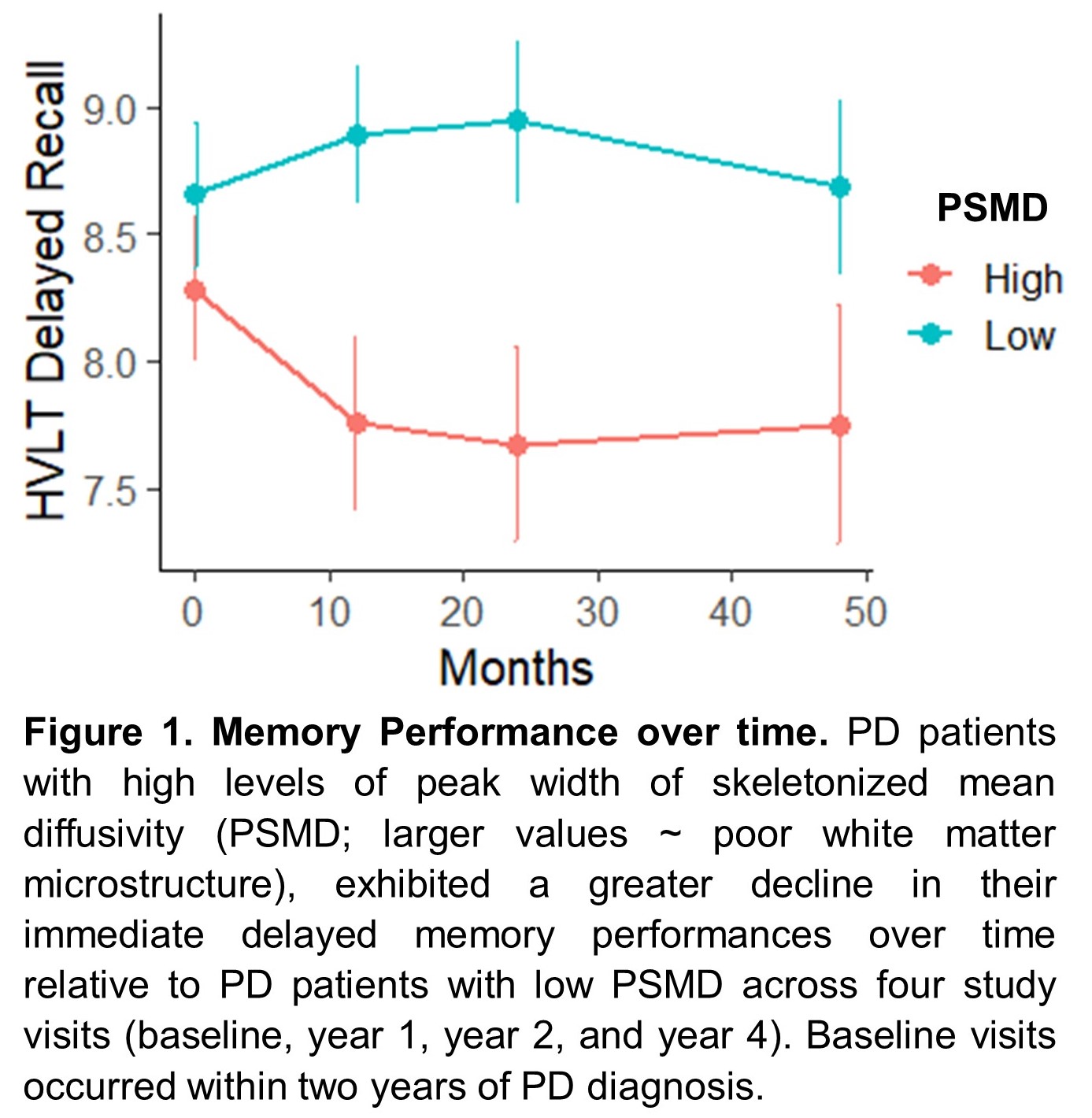Category: Parkinson's Disease: Cognitive functions
Objective: Examine whether a recently developed MRI biomarker intended to assess cerebrovascular small vessel disease, peak width of skeletonized mean diffusivity (PSMD)[1], predicts cognitive decline in Parkinson’s disease (PD).
Background: Cognitive decline in Parkinson’s disease (PD) is a significant predictor of functional impairment and does not respond well to existing treatments [2]. White matter hyper-intensities are associated with a reduction in cognitive function and predict cognitive decline in PD patients [3], [4]. Reductions in white matter microstructure metrics, such as PSMD, precede the development of white matter hyper intensities [5], suggesting they are more suitable markers to detect and quantify early white matter changes in PD.
Method: This study used data from a cohort of de novo PD patients and healthy controls (HC) enrolled in the Parkinson’s Progression Markers Initiative. We calculated longitudinal PSMD values from participants that had diffusion weighted imaging data available. Neuropsychological data included in the current analyses included at least one test from each of the major cognitive domains, which served as dependent variables in our statistical models. Linear mixed-effects models were used to determine whether PSMD was associated with the rate of cognitive decline during the four-year follow-up. The impact on decline is represented by the interaction term between PSMD and time, adjusted for cardiovascular risk, Movement Disorders Society – Unified Parkinson’s Disease Rating Scale (MDS-UPDRS) – part III, Levodopa Equivalency Dose (LEDD), age, sex, and education.
Results: 139 PD and 66 HC were identified with diffusion imaging and T1‐weighted MRI sequences. PSMD was associated with a decline in memory performances over time [Hopkins Verbal Learning Test Total Immediate Recall (p < 0.001) and Delayed Recall (p = 0.003); Figure 1]. No significant relationships were observed between the remaining cognitive variables examined.
Conclusion: PSMD, an indicator of white matter microstructure, may be an important predictor of memory in PD patients. As memory impairment is a significant predictor of dementia in PD, this may serve as an important metric to detect white matter changes early and help identify patients that may benefit from intervention.
References: [1] E. Baykara et al., “A novel imaging marker for small vessel disease based on skeletonization of white matter tracts and diffusion histograms,” Ann. Neurol., vol. 80, no. 4, pp. 581–592, 2016. [2] C. O’Callaghan and S. J. G. Lewis, “Cognition in Parkinson’s Disease,” in International review of neurobiology, vol. 133, Elsevier, 2017, pp. 557–583. [3] K. Shibata, M. Sugiura, Y. Nishimura, and H. Sakura, “The effect of small vessel disease on motor and cognitive function in Parkinson’s disease,” Clin. Neurol. Neurosurg., vol. 182, pp. 58–62, 2019. [4] L. M. Chahine et al., “Modifiable vascular risk factors, white matter disease and cognition in early Parkinson’s disease,” Eur. J. Neurol., vol. 26, no. 2, pp. 246-e18, 2019. [5] M. De Groot et al., “Changes in normal-appearing white matter precede development of white matter lesions,” Stroke, vol. 44, no. 4, pp. 1037–1042, 2013.
To cite this abstract in AMA style:
S. Ryman, C. Wertz, K. Poston, N. Shaff, A. Hartman, A. Horner, A. Mayer, A. Vakhtin, A. Deligtisch, S. Pirio Richardson. White matter and cognition in Parkinson’s disease [abstract]. Mov Disord. 2021; 36 (suppl 1). https://www.mdsabstracts.org/abstract/white-matter-and-cognition-in-parkinsons-disease/. Accessed January 5, 2026.« Back to MDS Virtual Congress 2021
MDS Abstracts - https://www.mdsabstracts.org/abstract/white-matter-and-cognition-in-parkinsons-disease/

